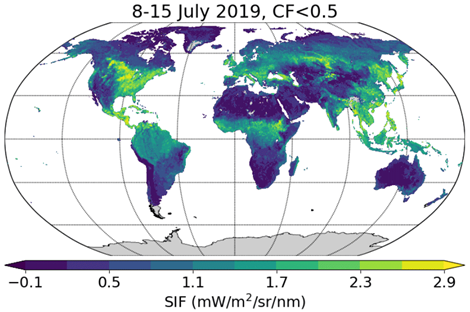Lead Supervisor: Tristan Quaife, University of Reading, Department of Meteorology
Email: t.l.quaife@reading.ac.uk
Co-supervisors: Becks Spake, University of Reading, Department of Biology, Brian Pickles, University of Reading, Department of Biology
Understanding the global carbon cycle is of the utmost importance to understanding climate change, and yet our observations of the individual components of the carbon cycle are surprisingly uncertain. Satellite based observations of Solar Induced Fluorescence (SIF) are the first direct measurement of the process of photosynthesis that can be made from space. Photosynthesis drives the single largest flux in the global carbon cycle and hence SIF observations have the potential to revolutionise our understanding of how the biosphere interacts with climate change. Although the processes that lead to fluorescence by chlorophyll are well understood in-vitro, there is still much uncertainty in how we can quantify photosynthetic uptake of carbon using satellite based observations of SIF. One important confounding factor is the sensitivity of the SIF signal to the 3D structure of vegetation canopies, which has direct control over the probability that a fluoresced photon will exit the canopy and be viewed by a satellite. This PhD project will examine the link between 3D vegetation structure and SIF, with the aim of providing a mechanistic description of the corresponding variability in the SIF signal. The student will use SIF data from the Copernicus Sentinel-5p mission (Figure 1.), and vegetation structure information collected by the NASA GEDI instrument onboard the International Space Station, which provides a unique, global view of the vertical structure of forests.

A map of SIF acquired by the Sentinel-5P instrument. Lighter colours indicate more fluorescence and correspond to areas of higher vegetation activity.
Taken from Guanter et al. (2021)
The main objective of this PhD project is to enhance our understanding of the linkages between the 3D vegetation structure and fluorescence. However, within this topic there is significant scope for the student to approach the underlying scientific problems according to their individual strengths. For example, the student could develop new, physically based models of the SIF signal. Alternatively, they might choose to address the problem from an empirical point of view and explore the data statistically. There are also a wide range of additional data sets that could be employed as part of the project, including field and aircraft observations.
Ultimately, this project will provide important information required to accurately monitor and model the global carbon cycle. Beyond the PhD project itself, there is significant potential for the student’s work to feed through into other activities, such as evaluation of the UK’s flagship climate model (UKESM), the monitoring of climate change impacts such as drought, and the development of new SIF retrieval algorithms by national space agencies.
The project will be run as part of the UK National Centre for Earth Observation (NCEO), and the student will be part of the NCEO community. They will be able to attend the annual NCEO science meetings and early-career researcher conferences, as well as take advantage of various training opportunities within the centre. NCEO is the UK’s leading research centre for using satellite data for environmental monitoring and has a strong background in the production and exploitation of SIF data. The PhD student will be able to take advice from a range of experts within the centre.
There is currently significant interest in the use of space borne measurements of SIF, and there are several new satellite missions planned, including the European Space Agency’s FLEX satellite (the world’s first dedicated SIF mission), and NASA’s GEOCARB, which will take SIF measurements throughout the diurnal cycle. Upon graduating, the student on this PhD project will be well positioned to become a researcher in this field with potential to secure jobs working directly with these, or other satellite missions.
Training opportunities:
The student on this project will be able to attend at least one international summer school, which will depend on the direction of the PhD. A likely candidate is “FluxCourse” (fluxcourse.org) which takes place each year in the Colorado Rockies and teaches the fundamentals of carbon flux observation and modelling and, typically, includes some instruction on SIF. In addition, the student will be well supported by post-doctoral staff on various projects run by the supervisory team and have access to training course offered by the UK National Centre for Earth Observation. There will be opportunities to present their research at least one international conference.
Student profile:
This project would be suitable for students with a degree in mathematics, physics, biology or a closely related environmental or physical science. The project will involve analysis of large data sets and some familiarity with programming, especially Python or R, would be advantageous.
References:
Guanter, L., Bacour, C., Schneider, A., Aben, I., van Kempen, T. A., Maignan, F., Retscher, C., Köhler, P., Frankenberg, C., Joiner, J., and Zhang, Y.: The TROPOSIF global sun-induced fluorescence dataset from the Sentinel-5P TROPOMI mission, Earth Syst. Sci. Data, 13, 5423–5440, https://doi.org/10.5194/essd-13-5423-2021, 2021

